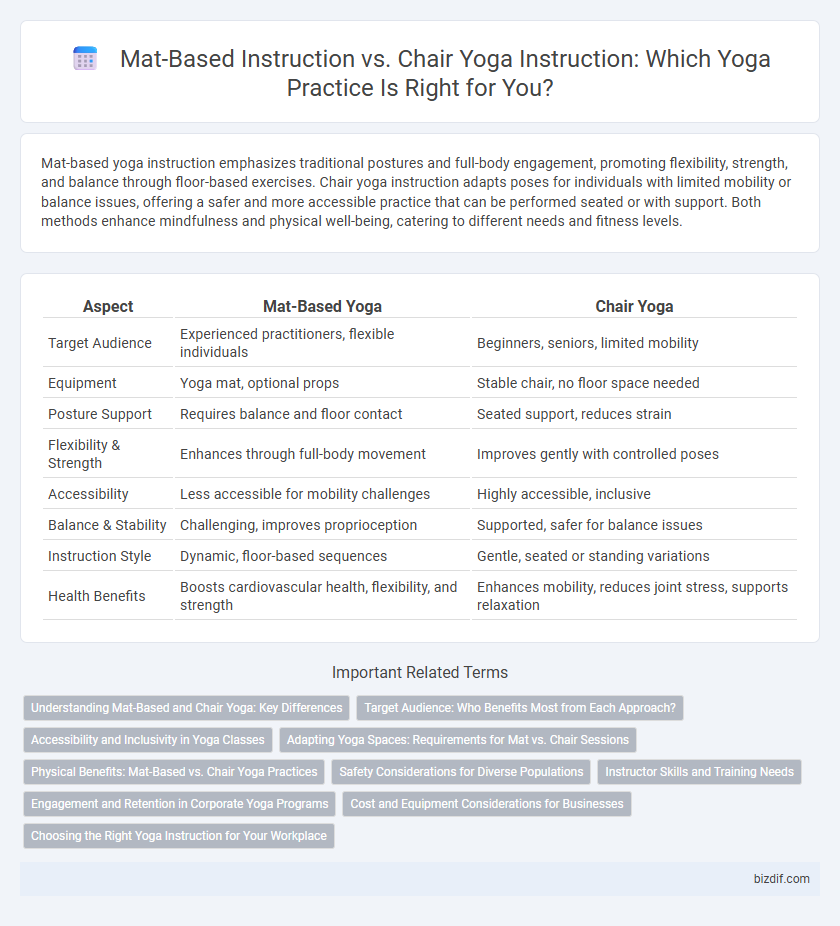Mat-based yoga instruction emphasizes traditional postures and full-body engagement, promoting flexibility, strength, and balance through floor-based exercises. Chair yoga instruction adapts poses for individuals with limited mobility or balance issues, offering a safer and more accessible practice that can be performed seated or with support. Both methods enhance mindfulness and physical well-being, catering to different needs and fitness levels.
Table of Comparison
| Aspect | Mat-Based Yoga | Chair Yoga |
|---|---|---|
| Target Audience | Experienced practitioners, flexible individuals | Beginners, seniors, limited mobility |
| Equipment | Yoga mat, optional props | Stable chair, no floor space needed |
| Posture Support | Requires balance and floor contact | Seated support, reduces strain |
| Flexibility & Strength | Enhances through full-body movement | Improves gently with controlled poses |
| Accessibility | Less accessible for mobility challenges | Highly accessible, inclusive |
| Balance & Stability | Challenging, improves proprioception | Supported, safer for balance issues |
| Instruction Style | Dynamic, floor-based sequences | Gentle, seated or standing variations |
| Health Benefits | Boosts cardiovascular health, flexibility, and strength | Enhances mobility, reduces joint stress, supports relaxation |
Understanding Mat-Based and Chair Yoga: Key Differences
Mat-based yoga emphasizes flexibility, balance, and core strength through floor poses requiring moderate to high mobility, ideal for individuals with physical agility. Chair yoga adapts traditional poses for seated or supported practice, prioritizing accessibility and safety for seniors or those with limited mobility, offering a gentle approach to enhance joint health and muscle tone. These differing modalities cater to varied fitness levels and physical conditions, highlighting the importance of personalized instruction for effective yoga practice.
Target Audience: Who Benefits Most from Each Approach?
Mat-based yoga instruction primarily benefits individuals seeking a comprehensive practice that enhances strength, flexibility, and balance through floor poses, ideal for those with moderate to high physical fitness levels. Chair yoga instruction targets seniors, people with limited mobility, and those recovering from injury by offering modified postures that improve joint health, circulation, and relaxation without the need to get down on the floor. Both approaches accommodate different needs, ensuring accessibility and safety while promoting physical and mental well-being.
Accessibility and Inclusivity in Yoga Classes
Mat-based instruction offers a traditional approach to yoga, encouraging full-body engagement but may pose challenges for individuals with limited mobility or balance issues. Chair yoga instruction enhances accessibility by adapting poses for seated practice, making yoga inclusive for seniors, people with disabilities, and those recovering from injuries. Incorporating chair yoga in classes expands participation and fosters a supportive environment for diverse physical abilities.
Adapting Yoga Spaces: Requirements for Mat vs. Chair Sessions
Mat-based yoga instruction demands ample floor space with non-slip surfaces to facilitate diverse poses and transitions, prioritizing cushioning and alignment aids like blocks or straps. Chair yoga instruction requires sturdy, stable chairs positioned with sufficient clearance to ensure safe seated or standing support, accommodating limited mobility and balance needs. Adapting yoga spaces involves optimizing layout, accessibility, and equipment selection to enhance comfort and functionality for each session type.
Physical Benefits: Mat-Based vs. Chair Yoga Practices
Mat-based yoga instruction enhances flexibility, strength, and balance through dynamic floor postures that engage multiple muscle groups, promoting overall physical fitness. Chair yoga instruction offers accessible modifications that improve circulation, joint mobility, and muscle tone, particularly benefiting individuals with limited mobility or balance challenges. Both practices contribute to improved physical health, with mat-based yoga emphasizing full-body engagement and chair yoga focusing on gentle, supported movements.
Safety Considerations for Diverse Populations
Mat-based yoga instruction requires attention to joint alignment and balance to prevent injuries, especially for beginners and those with mobility challenges. Chair yoga offers a safer alternative for older adults or individuals with limited flexibility, reducing fall risk while maintaining the benefits of yoga practice. Instructors must assess participant needs and modify poses accordingly to ensure safety across diverse populations.
Instructor Skills and Training Needs
Mat-based yoga instruction requires instructors to have strong skills in demonstrating poses, alignment, and transitions on the floor, demanding advanced knowledge of body mechanics and flexibility adaptations. Chair yoga instruction prioritizes training in modified poses that accommodate limited mobility, with an emphasis on safety, balance support, and adaptive techniques for seniors or individuals with disabilities. Both modalities necessitate specialized certifications to ensure instructors can effectively tailor sessions to participants' physical abilities and prevent injury.
Engagement and Retention in Corporate Yoga Programs
Mat-based yoga instruction promotes full-body engagement through dynamic poses, enhancing physical flexibility and core strength, which can lead to higher retention rates in corporate yoga programs due to visible progress. Chair yoga offers accessible modifications that increase participation among employees with limited mobility or time constraints, fostering inclusivity and sustained engagement over time. Tailoring the method to employee needs balances physical challenge and convenience, crucial for maximizing ongoing commitment and positive health outcomes in workplace wellness initiatives.
Cost and Equipment Considerations for Businesses
Mat-based yoga instruction requires investment in high-quality mats, storage space, and often additional props like blocks and straps, leading to higher initial costs and ongoing maintenance expenses. Chair yoga instruction minimizes equipment costs by utilizing readily available chairs, reducing the need for specialized materials and simplifying setup and cleanup for businesses. Choosing chair yoga can lower overhead and increase accessibility, making it a cost-effective option for fitness centers and wellness studios aiming to serve diverse client needs.
Choosing the Right Yoga Instruction for Your Workplace
Mat-based instruction offers a dynamic, full-range movement practice ideal for spacious workplaces with employees comfortable on the floor, promoting flexibility, strength, and balance. Chair yoga instruction adapts poses for seated or supported methods, making it accessible for individuals with limited mobility or those in office settings where floor space is restricted. Selecting the appropriate yoga instruction enhances employee wellness by aligning practice style with workplace environment and participant needs.
Mat-based instruction vs Chair yoga instruction Infographic

 bizdif.com
bizdif.com